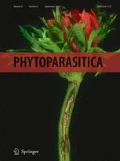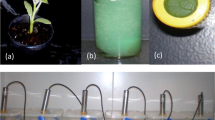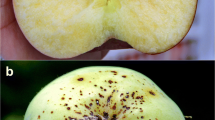Abstract
Infection of young parthenocarpic cucumber fruits byBotrytis cinerea begins in the petals. Removing petals or washing nutrients from the flower significantly reduced infection. Germination of conidia occurred at relative humidity (r.h.) above 92%, but when water deposition on artificial surfaces was prevented, germination did not occur even at 98% r.h. Germination of conidia on petals is promoted by deposition of an aqueous film not visible on the petal surface by the bare eye (but demonstrable by CoCl2). Provided there is a film of water on the surface of the host, germination and the infection process occur at a wide range of temperatures up to 25 °C. Pre-exposure of cucumber plants at temperatures as high as 30 °C or as low as 8 °C, prior to their infection and incubation under conditions conducive to gray mold, resulted in greater severity of the disease on young fruits or leaves as compared with plants previously incubated at 10-25 °C. The relevance of these results to cultural control of gray mold is discussed.
Similar content being viewed by others
References
Alderman, S.C. and Lacy, M.L. (1983) Influence of dew period and temperature on infection of onion leaves by dry conidia ofBotrytis squamosa.Phytopathology 73: 1020–1023.
Alderman, S.C. and Lacy, M.L. (1985) Influence of interruptions of dew periods on numbers of lesions produced on onion byBotrytis squamosa.Phytopathology 75: 808–810.
Bakker, J.C., Welles, G.A. and Uffelen, J.A.M. van (1987) The effect of day and night humidity on yield and quality of glasshouse cucumbers.J. Hortic. Sci. 62: 361–368.
Blakeman, J.P. (1975) Germination ofBotrytis cinerea conidiain vitro in relation to nutrient conditions on leaf surfaces.Trans. Br. Mycol. Soc. 65: 239–247.
Bulger, M.A., Ellis, M.A. and Madden, L.V. (1987) Influence of temperature and wetness duration on infection of strawberry flowers byBotrytis cinerea and disease incidence of fruit originating from infected flowers.Phytopathology 77: 1225–1230.
Carre, D.D. and Coyier, D.L. (1984) Influence of atmospheric humidity and free water on germ tube growth ofBotrytis cinerea.Phytopathology 74: 1136 (abstr.).
Devaux, A. (1978) Epidemiology of gray mold of strawberry and control trials.Phytoprotection 59: 19–24.
Deverall, B.J. and Wood, R.K.S. (1961) Infection of bean plants (Viciafaba L.) withBotrytis cinerea.B.fabae. Ann. Appl. Biol. 49: 461–472.
Elad, Y. (1988) Ultrastructural scanning electron microscopy study of parasitism ofBotrytis cinerea Pers. on flowers and fruit of cucumber.Trans. Br. Mycol. Soc. 91: 185–190.
Elad, Y. (1989) Effect of abiotic conditions on development of gray mold of rose and scanning electron microscopy.Phytopathol. Mediterr. 28: 122–130.
Elad, Y., Yunis, H. and Mahrer, Y. (1988) The effect of climatic condition in polyethylene covered structures on gray mold disease of winter cucumbers.Appl. Agric. Res. 3: 243–247.
Harrison, J.G. (1984) Effects of humidity on infection of field bean leaves byBotrytis fabae and on germination of conidia.Trans. Br. Mycol. Soc. 83: 245–248.
Hunter, J.E., Rohrbach, K.G. and Kumimoto, R.K. (1971) Epidemiology of Botrytis blight of macadamia racemes.Hawaii Agric. Exp. Stn. Bull. 62: 316–319.
Jarvis, W.R. (1990) Epidemiology. pp. 219-250.in: Coley Smith, J.R., Verhoeff, K. and Jarvis, W.R. [Eds.]. The Biology of Botrytis. Academic Press, London.
Johnson, R. (1954) Anthrone in the estimation of hexose sugars with special reference to pentose interference.Anal. Chem. 26: 1331–1333.
Maude, R.B. and Presly, A.H. (1980) Studies on the biology ofBotrytis species on overwintered salad onion.Ann. Appl. Biol. 94: 175–184.
Oke, T.R. (1978) Boundary Layer Climates. Methuen and Co. Ltd., London.
Powelson, R.L. (1960) Initiation of strawberry fruit rot caused byBotrytis cinerea.Phytopathology 50: 491–494.
Purkayastha, R.P. and Deverall, B.J. (1965) The growth ofBotrytis fabae andBotrytis cinerea into leaves of bean (Viciafaba L.).Ann. Appl. Biol. 56:139–147.
Salinas, J., Glandorf, D.C.M., Picavet, F.D. and Verhoeff, K. (1989) Effects of temperature, relative humidity and age of conidia on the incidence of spotting on gerbera flowers caused byBotrytis cinerea.Neth. J. Plant Pathol. 95: 51–64.
Shiraishi, M., Fukutomi, M. and Akai, S. (1970) Effect of temperature on the conidium germination and appressorium formation ofBotrytis cinerea Pers.Ann. Phytopathol. Soc. Jpn. 36: 234–236.
Shoemaker, P.B. and Lorbeer, J.W. (1977) The role of dew and temperature in the epidemiology of Botrytis leaf blight of onion.Phytopathology 67: 1267–1272.
Steekelenburg, N.A.M. van (1986) Factors influencing internal fruit rot of cucumber caused byDidymella bryoniae.Neth. J. Plant Pathol. 92: 81–91.
Wildman, H.G. and Parkinson, D. (1981) Comparison of germination ofCladosporium herbarum andBotrytis cinerea conidiain vitro in relation to nutrient conditions of leaf surfaces.Can. J. Bot. 59: 854–861.
Winston, P.W. and Bates, D.H. (1960) Saturated solutions for the control of humidity in biological research.Ecology 41:232–237.
Yunis, H., Elad, Y. and Mahrer, Y. (1990) Effects of air temperature, relative humidity and canopy wetness on gray mold of cucumbers in unheated greenhouses.Phytoparasitica 18: 203–215.
Yunis, H., Elad, Y. and Mahrer, Y. (1991) Influence of fungicidal control of cucumber and tomato gray mold (Botrytis cinerea) on fruit yield.Pestic. Sci. 31: 325–335.
Author information
Authors and Affiliations
Rights and permissions
About this article
Cite this article
Elad, Y., Yunis, H. Effect of microclimate and nutrients on development of cucumber gray mold (Botrytis cinerea). Phytoparasitica 21, 257–268 (1993). https://doi.org/10.1007/BF02980947
Received:
Issue Date:
DOI: https://doi.org/10.1007/BF02980947




